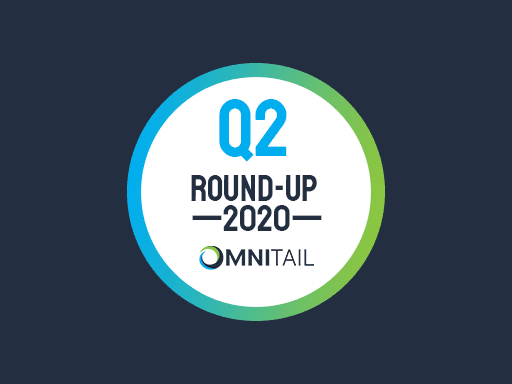As we reach the halfway point of 2020, ecommerce continues to grow. This quarter we saw some big updates from Google with regards to their ad formats, tools, and their entire algorithm. Amazon continues to thrive, and is expanding their shipping fleet, number of employees, and even dabbling into the world of video games. Finally, Facebook has continued to stick by small businesses and released a major update regarding their shopping services on Facebook and Instagram. Let’s look back at Q2 2020:

1. Updates to Ad Formats for Google
In Q2 we saw Google make changes across ad formats. The biggest change by far was the introduction of organic Google Shopping listings. Now, Google Shopping will consist primarily of free listings—with paid advertisements making up only a small percentage of listings.
Also on Google Shopping, in May Google tested an additional text snippet featured below Google Shopping ads in search results. As of now, this hasn’t been released as an official update, but is just a test Google is running. Look out for this in your search results!
Lastly, in June Google rolled out Discovery campaigns. These ads will use targeting based on audience (such as demographics and income) instead of past searches. Right now, there are two ad formats available: carousel ads and single images ads, but placements are limited.
Senior SEM Analyst’s Thoughts: Tim Moran


2. Facebook Aims to Help Small Businesses
While local businesses have been hit hard by the pandemic, Facebook aims to help. Back in March, Facebook released a $100 million program for small businesses impacted by the coronavirus.
In May, Facebook announced the release of Shops—a new shopping platform through Facebook and Instagram—which they say is aimed at helping small businesses survive these trying times. It will be free to sign up for Shops, but if customers purchase directly on Facebook or Instagram (instead of your site), Facebook will charge a commission fee.
Marketing Specialist’s Thoughts: Savannah St. John

On the other hand, I also think Facebook is stepping into a bigger playing field, and putting themselves in direct competition with Amazon and Google Shopping. It could be an interesting opportunity for big retailers to reach new customers.”

3. Amazon’s Growth Amid the Pandemic
Amazon had an interesting Q2. Riding a massive surge in online ordering, the company is uniquely placed to grow in the post-coronavirus economy and is hiring 100,000 additional workers to meet demand. Amazon also expanded its shipping fleet to help deal with demand. (Walmart, a main competitor, is also discontinuing Jet.com, their e-commerce outfit.)
Amazon isn’t the only one growing: UPS has just announced a new surcharge on retailers who are shipping at a much higher volume than earlier in the year.
Marketing Manager’s Thoughts: Christina DiSomma

On the other hand—some smaller e-commerce retailers may see major growth as people shop online to get what they can’t find in stores. These businesses may also be able to tap into the growth on Amazon by listing their products there. Only time will tell how these past few months – and shifting trends in retail—will impact e-commerce.”

4. Amazon and Google Increase Security
Both Amazon and Google took steps to verify sellers on their platforms this quarter. On April 23rd, Google announced that they will now require advertisers to complete a verification program in order to buy ads on Google. On April 27th, Amazon took similar measures. To fight fraud, Amazon will now use video conferencing to screen third-party sellers.
Senior SEM Analyst’s Thoughts: Sarah French


5. New Tools from Google
Google released a variety of new tools this quarter. These tools include:
Explanations (Beta) – Explanations will offer insights into large changes in your Google Ads account performance. Currently only available for Search campaigns using manual CPC or enhanced CPC bidding.
Core Web Vitals Report in Search Console – Google’s Core Web Vitals now have their own report in Search Console. This report will help quantify the user experience provided by your website. Using this report, you can gain insights into loading time, interactivity, and visual stability of your site.
Rising Retail Categories – This tool will help retailers gain more insights into consumer interests. It will show the latest growing categories and associated queries with the geographical areas where products are trending.
SEM Strategist’s Thoughts: Chris Kendall


6. Google’s New Algorithm Update
The new algorithm update started rolling out on May 4th. Google says the goal of this update is to improve the overall quality of search results. Supposedly, this update was bigger than many of the past changes and took at least 2 weeks to fully roll out.
Senior SEM Analyst’s Thoughts: CJ Milhoan

“Most people in the know are aware of Google’s big update that occurred on May 4th, however, a lot of people are scratching their heads about what this means. This can be even more exaggerated as search demand is on its head depending on what kind of retailer you are.
For example, retailers selling travel industry items have seen a huge hit because of COVID-19. On the other hand, fitness and home good retailers are thriving as people are having “staycations”. These are trends that can easily be identified and aren’t particularly earth-shattering. However, when you couple these demand trends with this new Google update—you have the potential for madness.
Unfortunately, because of this update Travel, Health, and Pet categories were the hardest hit. This doesn’t mean those categories cannot thrive. If you’re in one of these categories you’ll want to focus on how your organic traffic has changed since May 4th. Are you seeing fewer visits? Where does your site rank now after this update? If you suspect this update had a negative impact those are the questions you need to ask yourself.
From there it’s important to really look inward and be your harshest critic about your site and it’s content, is it relevant? Is it factual? This update couldn’t have come at a worse time for some retailers, but there are winners from this as well, so it’s not all doom and gloom. The key is finding out where you fall.”

That’s it for Q2. Did we miss any trends that are affecting your business? Let us know. Here’s to a successful Q3!








